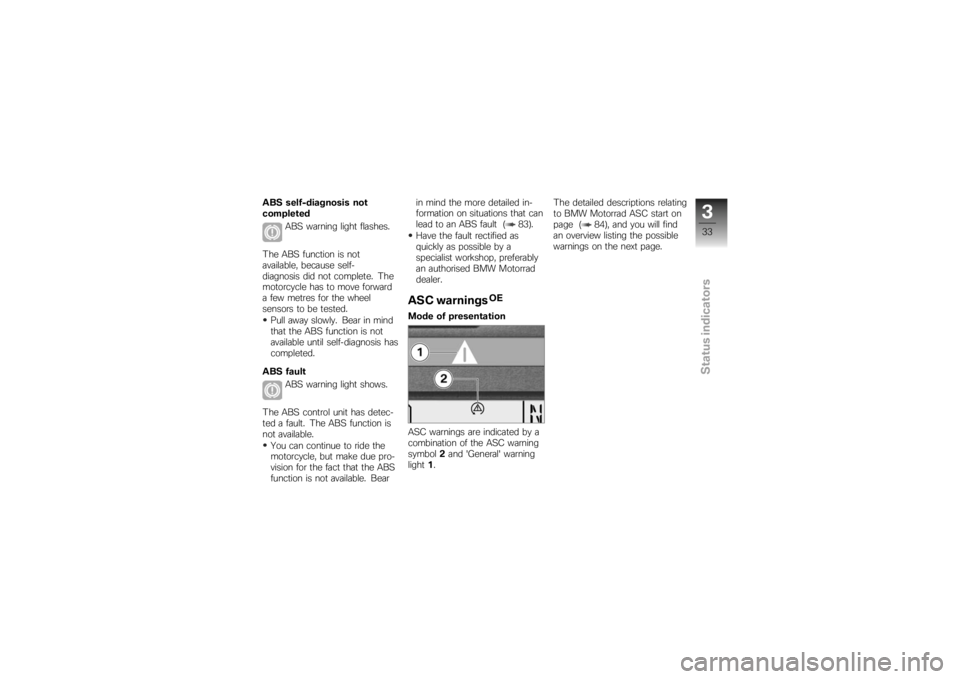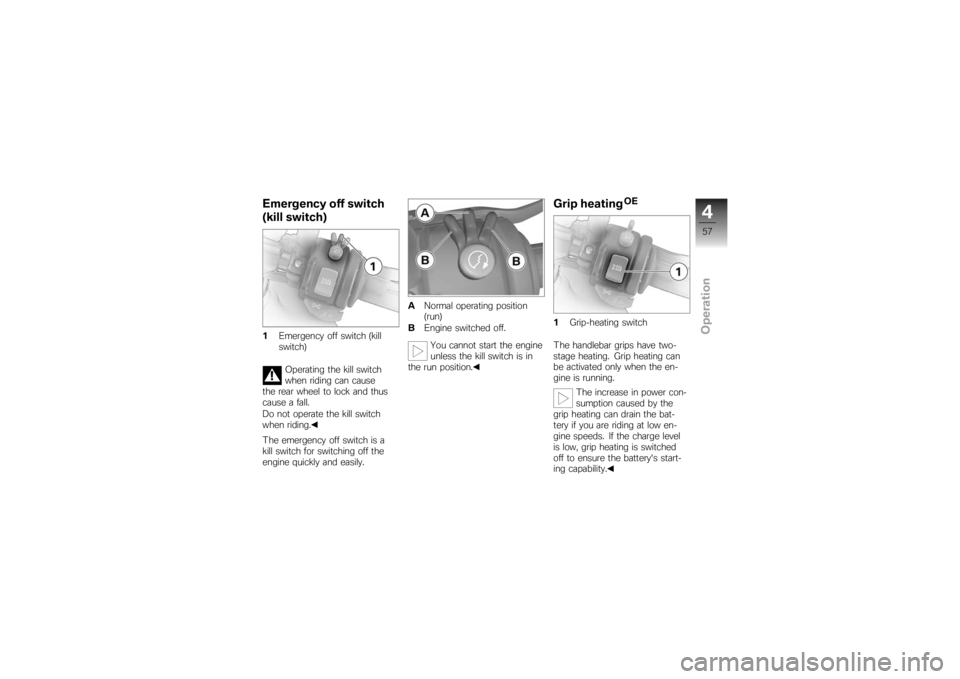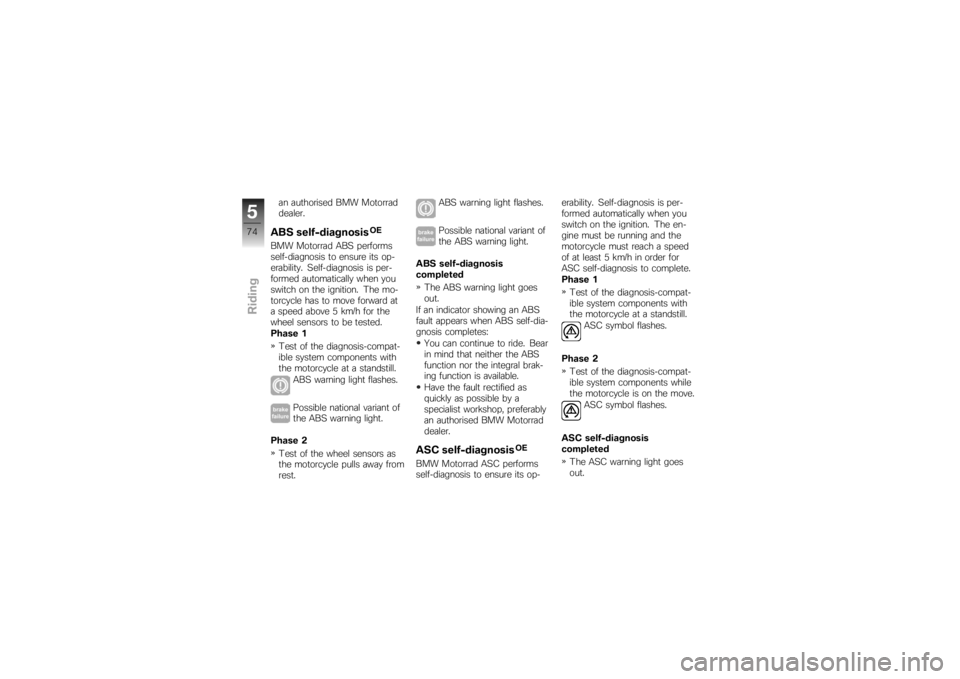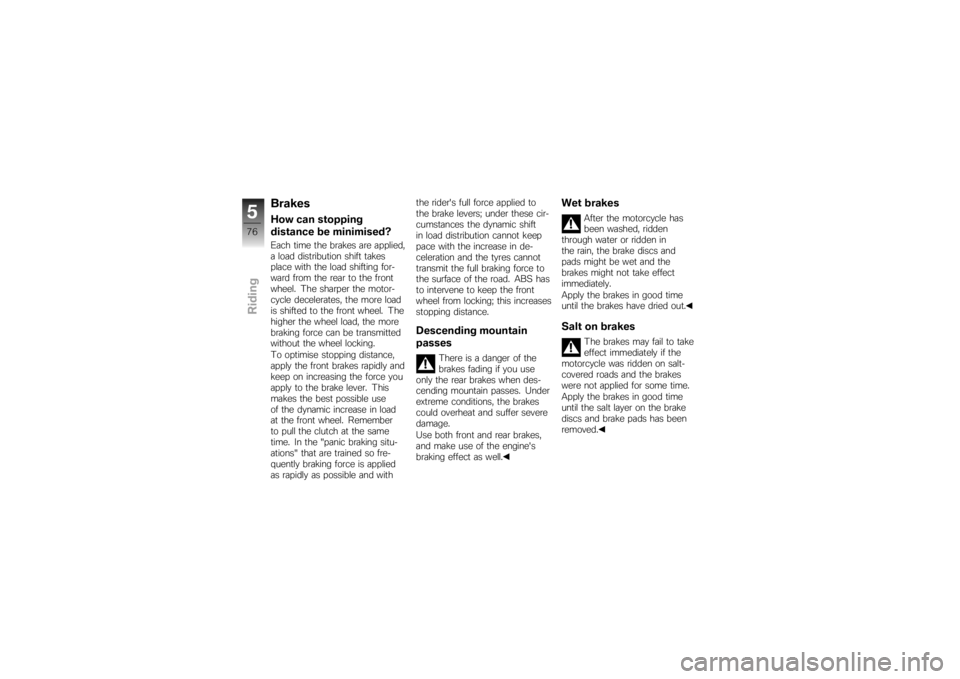wheel BMW MOTORRAD K 1200 R 2007 Rider's Manual (in English)
[x] Cancel search | Manufacturer: BMW MOTORRAD, Model Year: 2007, Model line: K 1200 R, Model: BMW MOTORRAD K 1200 R 2007Pages: 168, PDF Size: 2.85 MB
Page 5 of 168

5 Riding . . . . . . . . . . . . . . . . . . . . 69
Safety instructions . . . . . . . . . . . 70
Checklist . . . . . . . . . . . . . . . . . . . . . 72
Starting . . . . . . . . . . . . . . . . . . . . . . . 72
Running in . . . . . . . . . . . . . . . . . . . 75
Brakes . . . . . . . . . . . . . . . . . . . . . . . 76
Parking your motorcycle . . . . . 77
Refuelling . . . . . . . . . . . . . . . . . . . . 79
6 Engineering details . . . . . 81
Brake system with BMW Mo-
torrad Integral ABS
OE
........ 82
Electronic engine manage-
ment with BMW Motorrad
ASC
OE
....................... 84
Tyre pressure monitoring
RDC
OE
....................... 86
7 Accessories . . . . . . . . . . . . . 89
General instructions . . . . . . . . . . 90
Power socket . . . . . . . . . . . . . . . . 90
Luggage . . . . . . . . . . . . . . . . . . . . . 91
CaseOA
...................... 92
8 Maintenance . . . . . . . . . . . . 97
General instructions . . . . . . . . . . 98
Toolkit . . . . . . . . . . . . . . . . . . . . . . . . 98
Engine oil . . . . . . . . . . . . . . . . . . . . 99 Brake system, general . . . . . . 101
Brake pads . . . . . . . . . . . . . . . . . 102
Brake fluid . . . . . . . . . . . . . . . . . . 103
Clutch . . . . . . . . . . . . . . . . . . . . . . 105
Tyres . . . . . . . . . . . . . . . . . . . . . . . 106
Rims . . . . . . . . . . . . . . . . . . . . . . . 107
Wheels . . . . . . . . . . . . . . . . . . . . . 107
Front-wheel stand . . . . . . . . . . 115
Rear-wheel stand . . . . . . . . . . 116
Bulbs . . . . . . . . . . . . . . . . . . . . . . . 118
Jump starting . . . . . . . . . . . . . . 125
Battery . . . . . . . . . . . . . . . . . . . . . 126
9 Care . . . . . . . . . . . . . . . . . . . . . 131
Care products . . . . . . . . . . . . . . 132
Washing motorcycle . . . . . . . . 132
Cleaning easily damaged
components . . . . . . . . . . . . . . . . 132
Paint care . . . . . . . . . . . . . . . . . . 133
Protective wax coating . . . . . 134
Laying up motorcycle . . . . . . 134
Restoring motorcycle to
use......................... 134
10 Technical data . . . . . . . 135
Troubleshooting chart . . . . . . 136
Threaded fasteners . . . . . . . . 137
Engine . . . . . . . . . . . . . . . . . . . . . 139
Fuel . . . . . . . . . . . . . . . . . . . . . . . . 140
Engine oil . . . . . . . . . . . . . . . . . . 140
Clutch . . . . . . . . . . . . . . . . . . . . . . 141
Transmission . . . . . . . . . . . . . . . 141
Rear-wheel drive . . . . . . . . . . . 142
Running gear . . . . . . . . . . . . . . . 142
Brakes . . . . . . . . . . . . . . . . . . . . . 143
Wheels and tyres . . . . . . . . . . . 143
Electrics . . . . . . . . . . . . . . . . . . . . 146
Frame . . . . . . . . . . . . . . . . . . . . . . 147
Dimensions . . . . . . . . . . . . . . . . 148
Weights . . . . . . . . . . . . . . . . . . . . 148
Riding specifications . . . . . . . 149
11 Service . . . . . . . . . . . . . . . . 151
BMW Motorrad service . . . . . 152
BMW Motorrad service
quality . . . . . . . . . . . . . . . . . . . . . . 152
BMW Motorrad Service
Card: on-the-spot break-
down assistance . . . . . . . . . . . 152
Page 35 of 168

ABS self-diagnosis not
completedABS warning light flashes.
The ABS function is not
available, because self-
diagnosis did not complete. The
motorcycle has to move forward
a few metres for the wheel
sensors to be tested. Pull away slowly. Bear in mind
that the ABS function is not
available until self-diagnosis has
completed.
ABS fault ABS warning light shows.
The ABS control unit has detec-
ted a fault. The ABS function is
not available. You can continue to ride the
motorcycle, but make due pro-
vision for the fact that the ABS
function is not available. Bear in mind the more detailed in-
formation on situations that can
lead to an ABS fault ( 83).
Have the fault rectified as
quickly as possible by a
specialist workshop, preferably
an authorised BMW Motorrad
dealer.
ASC warnings
OE
Mode of presentation
ASC warnings are indicated by a
combination of the ASC warning
symbol 2and 'General' warning
light 1. The detailed descriptions relating
to BMW Motorrad ASC start on
page ( 84), and you will find
an overview listing the possible
warnings on the next page.
333zStatus indicators
Page 37 of 168

ASC interventionGeneral warning light quick-
flashes yellow.
ASC symbol appears on
the display.
The ASC has detected a degree
of instability at the rear wheel
and has intervened to reduce
torque. The warning light flashes
for longer than ASC intervention
lasts. This affords the rider visual
feedback on control intervention
even after the critical situation
has been dealt with.
Self-diagnosis not completed ASC symbol flashes.
Self-diagnosis did not complete,
so the ASC function is not avail-
able. The engine must be run-
ning and the motorcycle must
reach a speed of at least 5 km/h
in order for ASC self-diagnosis to
complete. Pull away slowly. Bear in mind
that the ASC function is not
available until self-diagnosis has
completed.
ASC switched off ASC symbol appears on
the display.
The rider has switched off the
ASC system.
with OE Automatic Stability
Control (ASC): Activate the ASC function
( 58)
ASC fault General warning light shows
yellow.
ASC symbol appears on
the display.
The ASC control unit has detec-
ted a fault. The ASC function is
not available. You can continue to ride. Bear
in mind that the ASC function is not available. Bear in mind
the more detailed information
on situations that can lead to
an ASC fault ( 85).
Have the fault rectified as
quickly as possible by a
specialist workshop, preferably
an authorised BMW Motorrad
dealer.
RDC warnings
OE
Mode of presentation
Warning symbol 2indicates a
critical tyre pressure, and the cor-
responding reading for the front
335zStatus indicators
Page 41 of 168

The motorcycle has not yet ac-
celerated past the threshold of
approximately 30 km/h. The
RDC sensors do not start trans-
mitting signals until the motor-
cycle reaches a speed above this
threshold ( 86).Increase speed above this
threshold and observe the RDC
readings. Assume that a per-
manent fault has not occurred
unless the 'General' warning
light comes on to accompany
the symptoms. Under these
circumstances:
Have the fault rectified by a
specialist workshop, preferably
an authorised BMW Motorrad
dealer.
Wireless communication with the
RDC sensors has been disrupted.
Possible causes include radio-
communication systems operat-
ing in the vicinity and interfering with the link between the RDC
control unit and the sensors.
Move to another location and
observe the RDC readings. As-
sume that a permanent fault
has not occurred unless the
'General' warning light comes
on to accompany the symp-
toms. Under these circum-
stances:
Have the fault rectified by a
specialist workshop, preferably
an authorised BMW Motorrad
dealer.
Sensor defective or system
error General warning light shows
yellow.
Tyre symbol appears on
the display.
"
--
"or"
-- --
" appears on
the display. Motorcycle is fitted with wheels
not equipped with RDC sensors.
Fit wheels and tyres equipped
with RDC sensors.
One or two RDC sensors have
failed. Have the fault rectified by a
specialist workshop, preferably
an authorised BMW Motorrad
dealer.
A system error has occurred. Have the fault rectified by a
specialist workshop, preferably
an authorised BMW Motorrad
dealer.
Battery of tyre-pressure
sensor weak General warning light shows
yellow.
RDC!
appears on the display.
This error message appears
only briefly after the pre-
ride check completes.
339zStatus indicators
Page 59 of 168

Emergency off switch
(kill switch)1Emergency off switch (kill
switch)
Operating the kill switch
when riding can cause
the rear wheel to lock and thus
cause a fall.
Do not operate the kill switch
when riding.
The emergency off switch is a
kill switch for switching off the
engine quickly and easily. A
Normal operating position
(run)
B Engine switched off.
You cannot start the engine
unless the kill switch is in
the run position.
Grip heating
OE
1 Grip-heating switch
The handlebar grips have two-
stage heating. Grip heating can
be activated only when the en-
gine is running. The increase in power con-
sumption caused by the
grip heating can drain the bat-
tery if you are riding at low en-
gine speeds. If the charge level
is low, grip heating is switched
off to ensure the battery's start-
ing capability.
457zOperation
Page 63 of 168

Push the protective cap over
the threaded fastener.Spring preloadSettingIt is essential to set spring pre-
load of the rear suspension to
suit the load carried by the mo-
torcycle. Increase spring preload
when the motorcycle is heavily
loaded and reduce spring preload
accordingly when the motorcycle
is lightly loaded.Adjusting spring preload
for rear wheelMake sure the ground is level
and firm and place the motor-
cycle on its stand.Your motorcycle's hand-
ling will suffer if you do not
match the spring-preload and
damping-characteristic settings.
Adjust the damping characteristic
to suit spring preload.
Adjusting spring preload
while the motorcycle is be-
ing ridden can lead to accidents.
Do not attempt to adjust spring
preload unless the motorcycle is
at a standstill.
If you want to increase spring
preload, turn knob 1in the dir-
ection indicated by the HIGH
arrow. If you want to reduce spring
preload, turn knob
1in the dir-
ection indicated by the LOW
arrow.
Basic setting of spring
preload, rear
Turn the knob as far as it will
go in the direction indicated
by the LOW arrow and then
turn it back 13 clicks in the
direction indicated by the
HIGH arrow. (Full load of
fuel, with rider 85 kg)
DampingSettingDamping must be adapted to
suit spring preload. An increase
in spring preload requires firmer
damping, a reduction in spring
preload requires softer damping.
461zOperation
Page 64 of 168

Adjusting damping for
rear wheelMake sure the ground is level
and firm and place the motor-
cycle on its stand.
Adjust the rear shock absorber,
using the tool from the on-
board toolkit to turn adjusting
screw1. If you want a harder damping
characteristic, turn the adjust-
ing screw in the direction indic-
ated by the H arrow.
If you want a softer damping
characteristic, turn the adjust-
ing screw in the direction indic-
ated by the S arrow. Basic setting of rear-sus-
pension damping charac-
teristic
Turn the adjusting screw as
far as it will go in the dir-
ection indicated by the H
arrow and then turn it back
one and a half turns in the
direction indicated by the S
arrow. (One-up 85 kg)
Electronic Suspension
Adjustment ESA
OE
SettingsElectronic Suspension Adjust-
ment ESA provides a convenient
way of adapting the motorcycle
to the load it carries and the sur-
face over which you intend riding.
462zOperation
Page 76 of 168

an authorised BMW Motorrad
dealer.ABS self-diagnosis
OE
BMW Motorrad ABS performs
self-diagnosis to ensure its op-
erability. Self-diagnosis is per-
formed automatically when you
switch on the ignition. The mo-
torcycle has to move forward at
a speed above 5 km/h for the
wheel sensors to be tested.
Phase 1Test of the diagnosis-compat-
ible system components with
the motorcycle at a standstill. ABS warning light flashes.
Possible national variant of
the ABS warning light.
Phase 2 Test of the wheel sensors as
the motorcycle pulls away from
rest. ABS warning light flashes.
Possible national variant of
the ABS warning light.
ABS self-diagnosis
completed The ABS warning light goes
out.
If an indicator showing an ABS
fault appears when ABS self-dia-
gnosis completes: You can continue to ride. Bear
in mind that neither the ABS
function nor the integral brak-
ing function is available.
Have the fault rectified as
quickly as possible by a
specialist workshop, preferably
an authorised BMW Motorrad
dealer.
ASC self-diagnosis
OE
BMW Motorrad ASC performs
self-diagnosis to ensure its op- erability. Self-diagnosis is per-
formed automatically when you
switch on the ignition. The en-
gine must be running and the
motorcycle must reach a speed
of at least 5 km/h in order for
ASC self-diagnosis to complete.
Phase 1
Test of the diagnosis-compat-
ible system components with
the motorcycle at a standstill. ASC symbol flashes.
Phase 2 Test of the diagnosis-compat-
ible system components while
the motorcycle is on the move. ASC symbol flashes.
ASC self-diagnosis
completed The ASC warning light goes
out.
574zRiding
Page 78 of 168

BrakesHow can stopping
distance be minimised?Each time the brakes are applied,
a load distribution shift takes
place with the load shifting for-
ward from the rear to the front
wheel. The sharper the motor-
cycle decelerates, the more load
is shifted to the front wheel. The
higher the wheel load, the more
braking force can be transmitted
without the wheel locking.
To optimise stopping distance,
apply the front brakes rapidly and
keep on increasing the force you
apply to the brake lever. This
makes the best possible use
of the dynamic increase in load
at the front wheel. Remember
to pull the clutch at the same
time. In the "panic braking situ-
ations" that are trained so fre-
quently braking force is applied
as rapidly as possible and withthe rider's full force applied to
the brake levers; under these cir-
cumstances the dynamic shift
in load distribution cannot keep
pace with the increase in de-
celeration and the tyres cannot
transmit the full braking force to
the surface of the road. ABS has
to intervene to keep the front
wheel from locking; this increases
stopping distance.
Descending mountain
passes
There is a danger of the
brakes fading if you use
only the rear brakes when des-
cending mountain passes. Under
extreme conditions, the brakes
could overheat and suffer severe
damage.
Use both front and rear brakes,
and make use of the engine's
braking effect as well.
Wet brakes
After the motorcycle has
been washed, ridden
through water or ridden in
the rain, the brake discs and
pads might be wet and the
brakes might not take effect
immediately.
Apply the brakes in good time
until the brakes have dried out.
Salt on brakes
The brakes may fail to take
effect immediately if the
motorcycle was ridden on salt-
covered roads and the brakes
were not applied for some time.
Apply the brakes in good time
until the salt layer on the brake
discs and brake pads has been
removed.
576zRiding
Page 84 of 168

Brake system with
BMW Motorrad Integral
ABS
OE
Partially integral brakesYour motorcycle is equipped with
partially integral brakes. Both
front and rear brakes are applied
when you pull the handbrake
lever. The footbrake lever acts
only on the rear brake.
While the brakes are slowing the
motorcycle, the BMW Motorrad
Integral ABS adapts braking-force
distribution between front and
rear brakes to suit the load on
the motorcycle.The integral braking func-
tion makes it very difficult
to spin the rear wheel by opening
the throttle with the front brake
applied to keep the motorcycle
stationary (burn-out). Attempted
burn-outs can result in damage
to the rear brake and the clutch.
Do not attempt burn-outs.
How does ABS work?The amount of braking force that
can be transferred to the road
depends on factors hat include
the coefficient of friction of the
road surface. Loose stones, ice
and snow or a wet road all have
much lower coefficients of fric-
tion than a clean, dry asphalt sur-
face. The lower the coefficient
of friction, the longer the braking
distance.
If the rider increases braking
pressure to the extent that brak-
ing force exceeds the maxim-
um transferrable limit, the wheels
start to lock and the motorcycle
loses its directional stability; a fall
is imminent. Before this situation
can occur, ABS intervenes and
adapts braking pressure to the
maximum transferrable braking
force, so the wheels continue
to turn and directional stability
is maintained irrespective of the
condition of the road surface.
What are the effects of
surface irregularities?Humps and surface irregular-
ities can cause the wheels to
lose contact temporarily with the
road surface; if this happens the
braking force that can be trans-
mitted to the road can drop to
zero. If the brakes are applied
under these circumstances the
ABS has to reduce braking force
to ensure that directional sta-
bility is maintained when the
wheels regain contact with the
road surface. At this instant the
BMW Motorrad Integral ABS
must assume an extremely low
coefficient of friction, so that the
wheels will continue to rotate un-
der all imaginable circumstances,
because this is the precondition
for ensuring directional stability.
As soon as is registers the ac-
tual circumstances, the system
reacts instantly and adjusts brak-
682zEngineering details